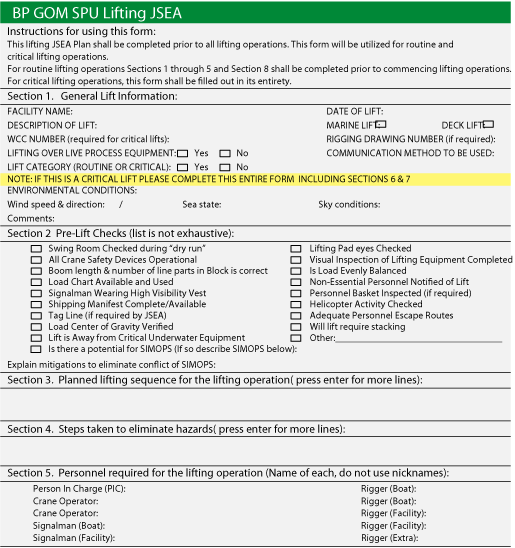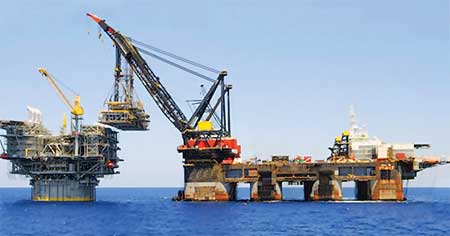Lift planning begins with the distinction between routine and critical lifts.
Jake Reidenbach, BP
What’s a lift plan? Unfortunately, these are words that are heard all too often following a lifting incident. The oil and gas exploration and production industry has seen a decrease in serious lifting incidents and fatalities in recent years; however, there is always room for improvement. Following the introduction of the International Association of Oil & Gas Producers (OGP) recommended practice, Report 376 “Lifting & Hoisting Safety,” BP America began a complete rewrite of its own lifting standard to mirror that set by OGP for planning of lifting operations.1 With this rewrite came the introduction of the new lift planning criterion used in BP GOM operations. This new lift planning criterion was designed to add more rigor and safeguards around lifting operations as well as to simplify the process.
All BP GOM lifting operations have lift plans that document the job scope, hazards, risks and controls of the lifting operation. The detail required is related to the risk and complexity of the lift. All lift plans in BP GOM operations use a standardized framework for developing a lift plan that includes:
- Person In Charge (PIC) of operations
- Number of personnel required
- Personnel roles and responsibilities
- Configuration/weight of load and lifting points
- Pickup and setdown areas with any constraints
- Equipment required and certification
- Step-by-step instructions
- Communications to be used; e.g., signaling methods
- Emergency and rescue plans
- Restrictions on lifting operations; e.g., maximum permissible wind speeds
- Access and egress for slinging and un-slinging the load
- Permit to work (if required) in light of simultaneous, conflicting or nearby operations
- Load integrity checks
- An assessment of whether tag lines should be used.
LIFT CATEGORIES
BP GOM lifting operations fall into two categories: routine lifts and critical lifts. Each category requires a different level of documentation and control based upon the complexity and potential severity, Table 1. All lifts are categorized, planned, and carried out according to the lift plan. BP GOM operations use the BP GOM lifting Job Safety & Environmental Analysis (JSEA) plan, which are used for both routine and critical lifting operations, Fig. 1.
| TABLE 1. Distinction between routine and critical lifts. |
 |
|
 |
|
Fig. 1. BP’s Job Safety and Environmental Analysis (JSEA) is required for all lifting operations.
|
|
The classifications for routine lifts are: lifts within normal operating parameters of the equipment; lifting over non-sensitive areas; suitable environmental conditions within operational skill level of the crane operator; typical load shape and center of gravity; and standard rigging arrangements. All routine lifts require a BP GOM lifting JSEA plan, which includes on-site pre-job review, reviewing questions for a safe lift, designation of a person in charge, and a permit to work (if applicable).
The classifications for critical lifts are: lifting of personnel for work activities; heavy lifts - classified as 80% of the crane’s rated capacity (OGP Report 376 defines heavy lifts as those exceeding 90% of rated capacity), Fig. 2; the lifting operation approaches the skill level of the crane operator; tandem lifts (e.g., tallying pipe using crane and winch); lifting in sensitive, difficult or restricted areas/high wind/sea conditions; non-standard rigging arrangements; subsea lifts; others as determined locally by the Offshore Installation Manager.
 |
|
Fig. 2. Offshore heavy lifting operation.
|
|
All critical lifts also require a BP GOM lifting JSEA plan, which includes an on-site, pre-job review for a safe lift, designation of a person in charge, receipt of a permit to work, and specific engineering input (if required).
BEST PRACTICES
Reviews of lifting incidents have identified the three best practices deemed as critical to safe lifting operations. They are: 1) a JSEA and lift plan required for all lifting operations, including a requirement to stop any jobs that deviate from the plan; 2) hazard identification and risk assessment as an integral part of safe lift planning; and 3) an assessment of the lift and determination of the lift method, equipment, and number of personnel required that are critical to planning the lift. 
LITERATURE CITED
1 International Association of Oil & Gas Producers “Lifting & hoisting safety recommended practice,” Report No. 376, April 2006.
|
THE AUTHOR
|
| |
Jake Reidenbach is a Lifting & Hoisting Specialist for BP America. He can be contacted at Jacob.Reidenbach@bp.com.
|
|
|





